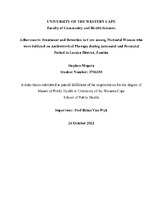| dc.description.abstract | Introduction: Mother-to-child transmission (MTCT) is the cause of most HIV acquisition among children. Prevention of mother-to-child transmission (PMTCT) of HIV programs aim to enable pregnant women to attain viral suppression so that they are unlikely to pass HIV to the
foetus in utero or during birth, and to the neonate during breastfeeding. The Option B+ treatment regimen - initiating pregnant and breastfeeding women, diagnosed with HIV, on lifelong triple antiretroviral therapy (ART) regardless of their WHO clinical stage – was introduced in 2013 in Zambia but to date, no evaluation of this program has been done. Study Aim: The current study described factors associated with adherence and retention in care(RIC) among postnatal women initiated on ART during the antenatal and postnatal period at five PMTCT centres in Lusaka District, Zambia in 2017 and 2018. Methodology: A quantitative, retrospective cohort analysis of 311 postnatal women who were initiated on option B+ regimen at five PMTCT centres in Lusaka District between 1 January 2017 and 30 April 2018 was done. Adherence to treatment was measured by analysing data on patients’ missed clinic appointments and self-reported missed medication doses. Kaplan-Meier survival analysis was used to calculate RIC at 6, 12, 18, and 24 months. Bivariate analysis was conducted to determine the significance of associations between adherence and RIC, and sociodemographic and clinical characteristics, respectively. Results: Retention in care decreased over time, from 92% at the time of delivery to 81%, 77%, 74% and 70% at 6, 12, 18 and 24 months postnatal, respectively. Higher retention in care was observed amongst married women (p=0.012); who stayed within one kilometer from the health facility (p=0.018); whose spouses were on ART (p=0.027); who knew their HIV status before pregnancy (p=0.005); who were commenced on ART in the first trimester (p=<0.001); and the postnatal period (p=<0.001); who were on other medication, in addition to ART (p=0.001); who
did not miss a dose of medication in the week before the last appointment (p=<0.001); and who did not miss any clinic appointment since commencing ART (p=<0.001). Half of the study participants (50.2%; n=155) reported optimal adherence (did not miss a scheduled clinic appointment since commencing ART). Optimal adherence to ART was significantly associated with women who lived within 1 km from the health facility (p=0.012) and who had a treatment supporter (p=0.030). Conclusion: Half of the study participants had optimal adherence to their scheduled clinic visits since enrolment into the Option B+ program, and 30% were lost to follow up over the first two years. Staying closer to the health facility where the woman received ART, knowing one’s HIV status before pregnancy or earlier in pregnancy, and initiating ART earlier in pregnancy, increased the likelihood of optimal adherence to ART and RIC at 24 months postnatal. Additionally, having a treatment supporter increased the likelihood of optimal adherence. | en_US |

